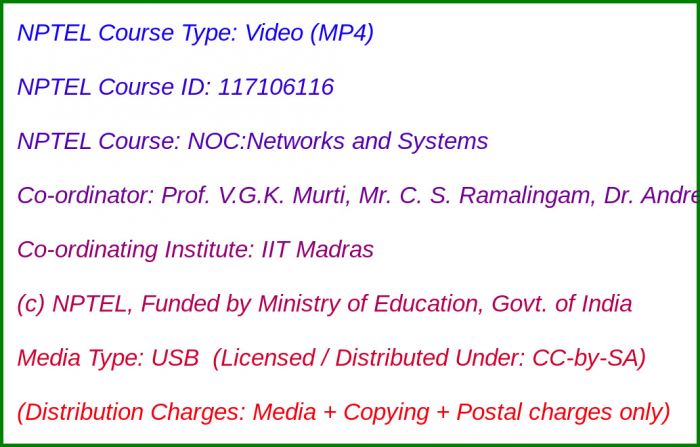
Media Storage Type : 32 GB USB Stick
NPTEL Subject Matter Expert : Prof. V.G.K. Murti, Mr. C. S. Ramalingam, Dr. Andrew Thangaraj
NPTEL Co-ordinating Institute : IIT Madras
NPTEL Lecture Count : 78
NPTEL Course Size : 4.5 GB
NPTEL PDF Text Transcription : Available and Included
NPTEL Subtitle Transcription : Available and Included (SRT)
Lecture Titles:
Lecture 1 - Functions in circuits - constant and sinusoidal functions
Lecture 2 - Functions in circuits - Exponential function
Lecture 3 - Complex numbers and other topics
Lecture 4 - Systems, Signals, Networks
Lecture 5 - Representation and Classification of Systems
Lecture 6 - Linear systems
Lecture 7 - Time-invariance and causality
Lecture 8 - Signals, Elementary continuous signals
Lecture 9 - Complex frequencies of signals
Lecture 10 - Discontinuous signals - step, ramp
Lecture 11 - Unit impulse or delta function
Lecture 12 - Basic discrete-time signals
Lecture 13 - Examples of Signals
Lecture 14 - Introduction to Systems, Complementary Functions, Initial Conditions
Lecture 15 - Special initial conditions
Lecture 16 - Characterization of a linear system
Lecture 17 - Impulse Response
Lecture 18 - Evaluating the Convolution Integral
Lecture 19 - Worked-out Problems
Lecture 20 - Introduction and Motivation
Lecture 21 - Evaluating Fourier series coefficients
Lecture 22 - Symmetry conditions
Lecture 23 - Symmetry Condition Examples
Lecture 24 - Application to Network Analysis
Lecture 25 - Exponential Fourier Series
Lecture 26 - Frequency Spectrum
Lecture 27 - Examples
Lecture 28 - Signal Power and Related Ideas
Lecture 29 - Convergence of Fourier Series
Lecture 30 - Week 1 Solutions
Lecture 31 - Hints for Assignment 2
Lecture 32 - Hints for Assignment 3
Lecture 33 - Additional Properties of Fourier Series
Lecture 34 - Exercises on Fourier Series
Lecture 35 - Lab Demo
Lecture 36 - From Fourier Series to Fourier Transform
Lecture 37 - Continuous Time Fourier Transform
Lecture 38 - Fourier Transform Examples
Lecture 39 - Examples and Some Properties of Fourier Transform
Lecture 40 - Properties of Fourier Transform (contd.)
Lecture 41 - More Fourier Transform Properties
Lecture 42 - Energy Considerations
Lecture 43 - Energy Considerations II
Lecture 44 - Helpful Relationships for Inverse Fourier Transform
Lecture 45 - Fourier transform of signals that are not absolutely integrable
Lecture 46 - Fourier Transform of Periodic Signals, Unit Step and Signum Function
Lecture 47 - Truncated Sine wave and Convolution properties
Lecture 48 - Integration in Time domain
Lecture 49 - Application of continuous-time Fourier transform to system analysis
Lecture 50 - Comments about transient analysis
Lecture 51 - Sampling Theorem and Exercises on Fourier Transforms
Lecture 52 - Introduction to Laplace Transform
Lecture 53 - Laplace transforms of important functions
Lecture 54 - Recap, Poles / Zeros and Laplace Transform Notation
Lecture 55 - Properties: Linearity, differentiation in the time domain
Lecture 56 - Application and properties of Laplace transform
Lecture 57 - More properties of Laplace transform: Shift in frequency domain
Lecture 58 - More properties of Laplace transform
Lecture 59 - Properties: Division by `t, Initial value theorem, Final value theorem
Lecture 60 - Properties: Convolution in time domain
Lecture 61 - Complex convolution and periodic functions
Lecture 62 - Examples of Laplace transform
Lecture 63 - Laplace transform examples
Lecture 64 - Inverse Laplace transform
Lecture 65 - Partial fractions: general case
Lecture 66 - Inverse Laplace Transform and Contour Integration
Lecture 67 - Relating Fourier and Laplace Transform
Lecture 68 - Exercises
Lecture 69 - Applications of Laplace transform to network transients
Lecture 70 - Laplace transform for resistor and system analysis
Lecture 71 - Laplace transform method for mutual inductance
Lecture 72 - Mutual Inductance Continued
Lecture 73 - Examples and Advantages of L-transform
Lecture 74 - General LTI systems and more about H(s)
Lecture 75 - Many facets of the system function (contd)
Lecture 76 - Frequency response and stability
Lecture 77 - Full circuit example
Lecture 78 - Exercises

